外研必修4 Module 3 Body Language and Non-verbal Communication Reading and Vocabulary 课件(共37张PPT)
文档属性
| 名称 | 外研必修4 Module 3 Body Language and Non-verbal Communication Reading and Vocabulary 课件(共37张PPT) | 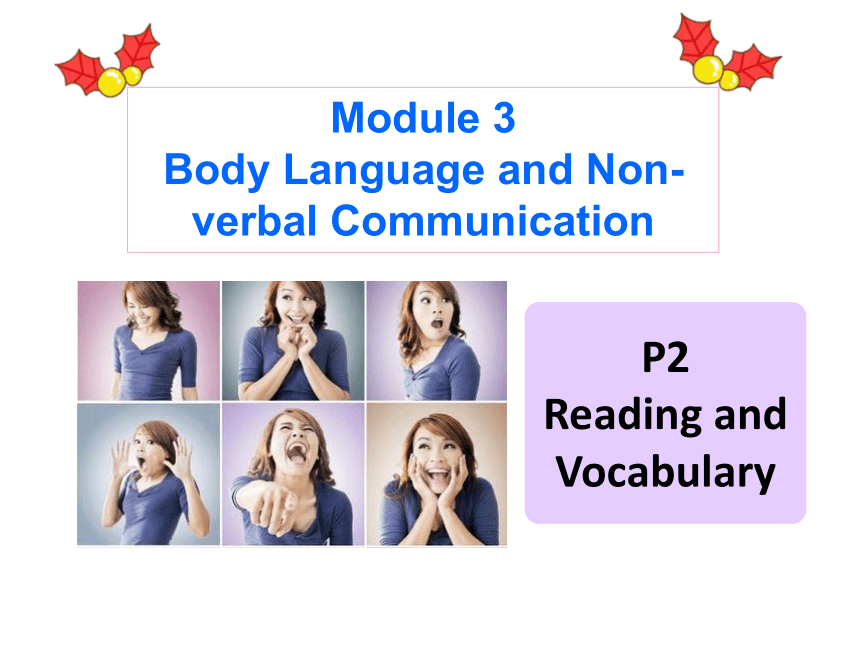 | |
| 格式 | zip | ||
| 文件大小 | 1.3MB | ||
| 资源类型 | 教案 | ||
| 版本资源 | 外研版 | ||
| 科目 | 英语 | ||
| 更新时间 | 2019-03-27 10:07:34 | ||
图片预览

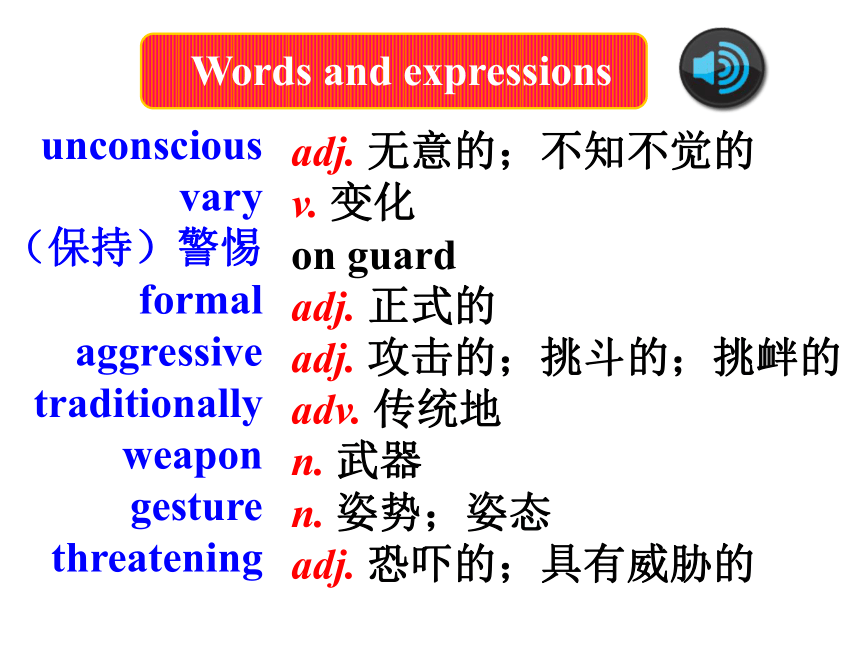
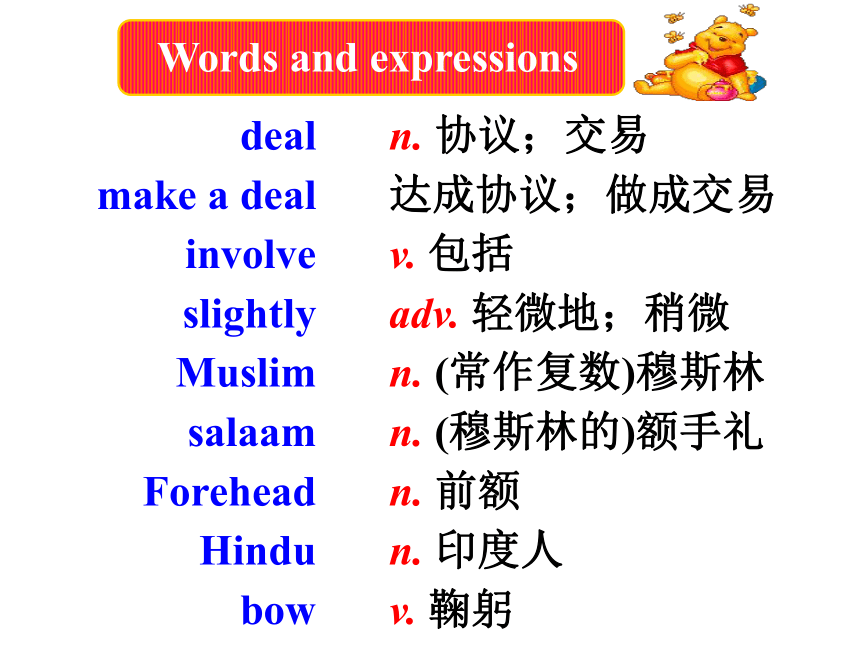
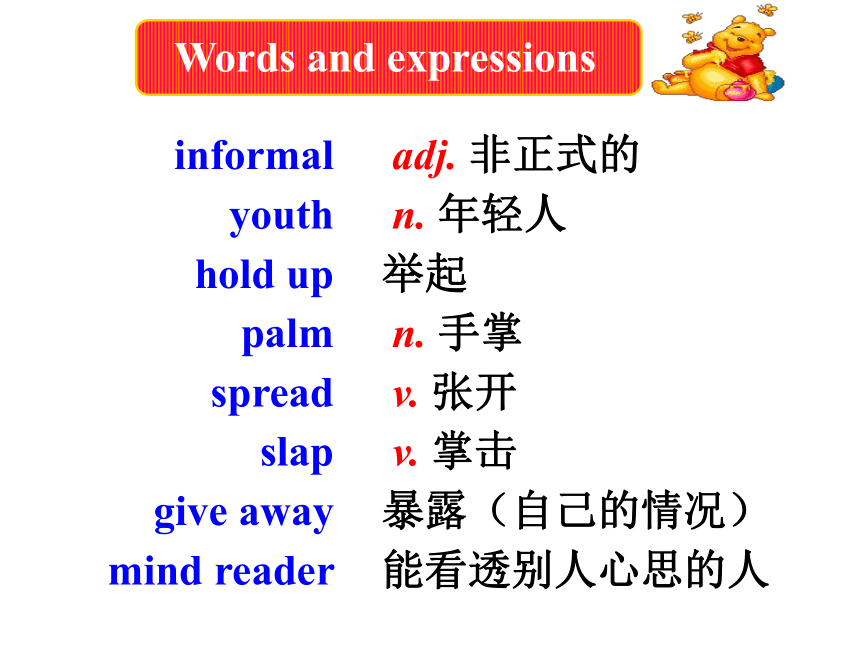
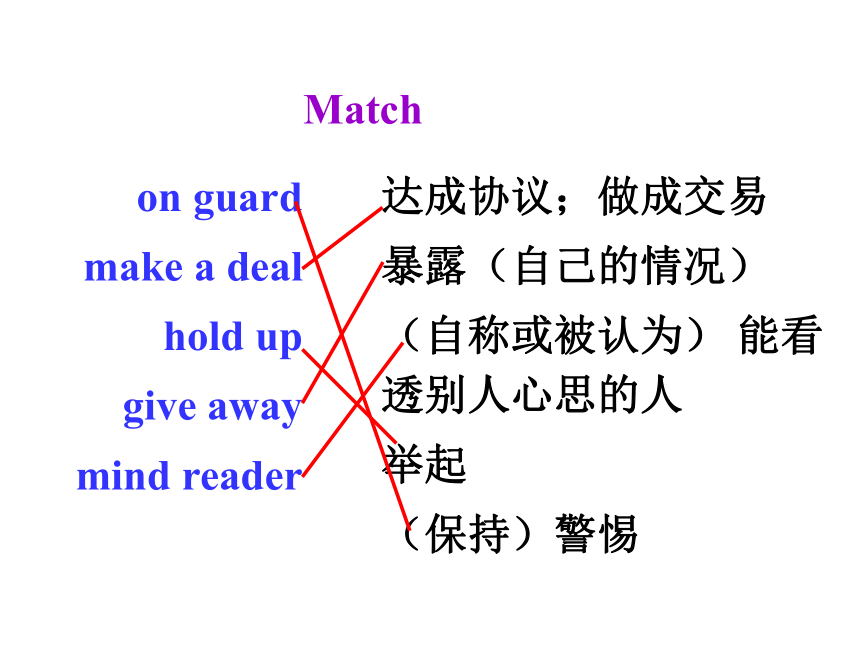
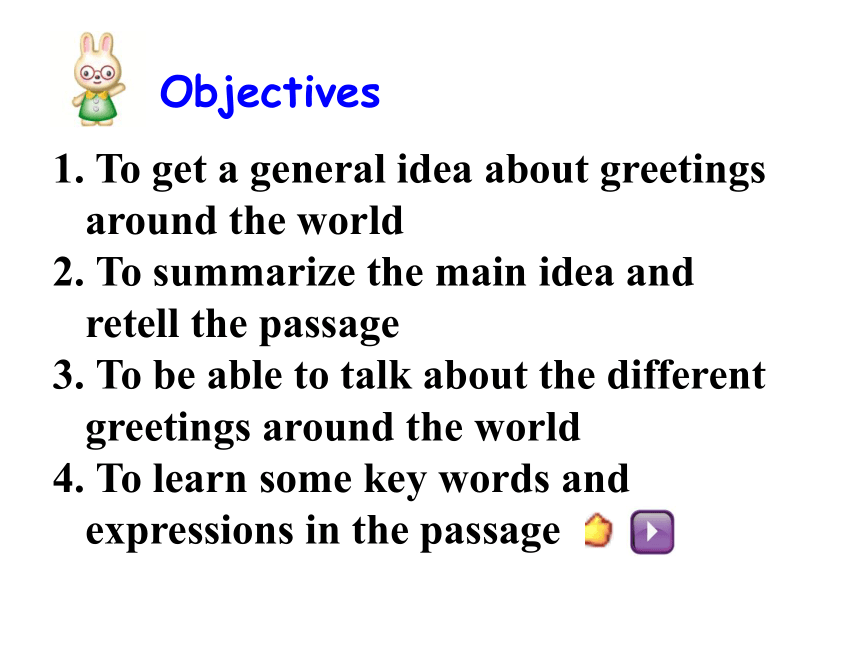
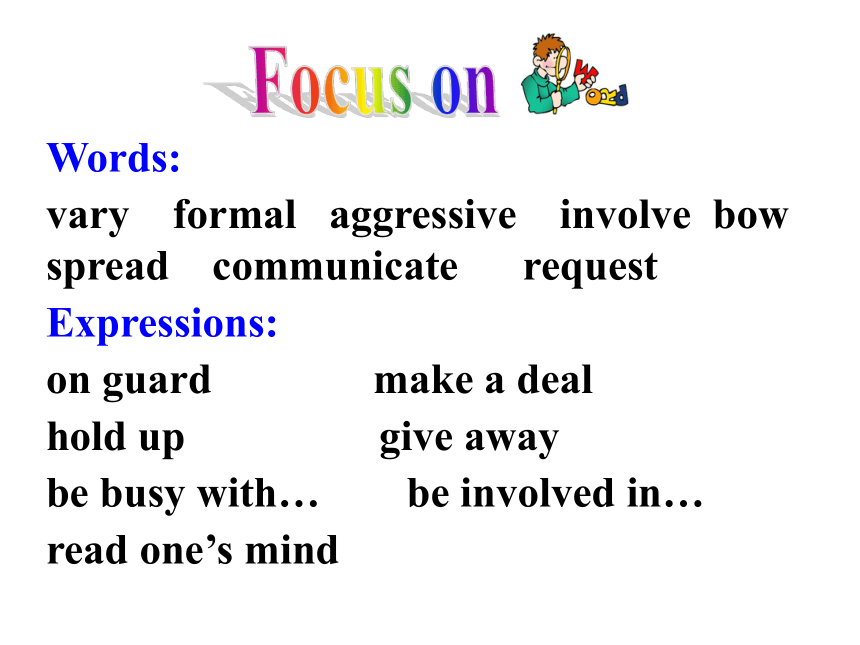
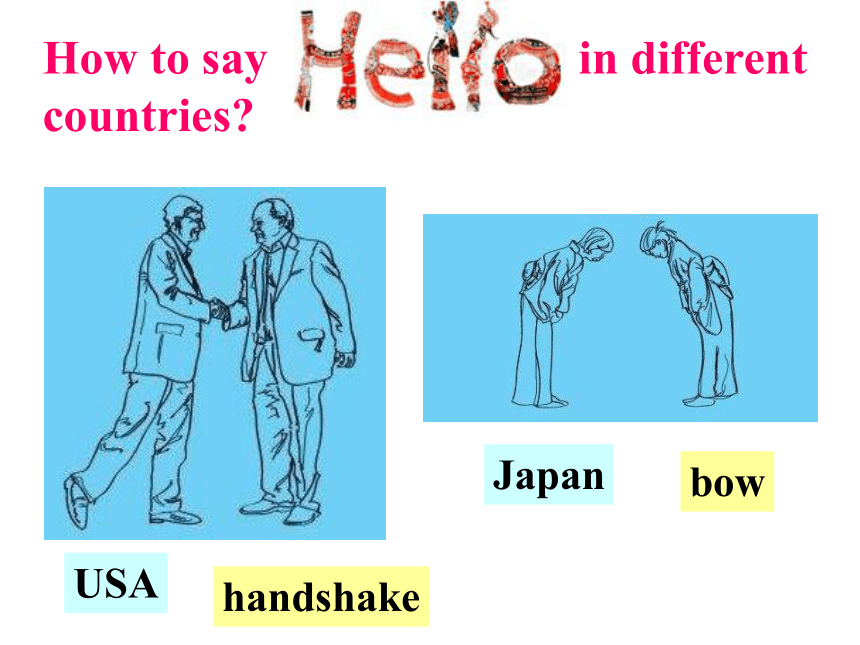
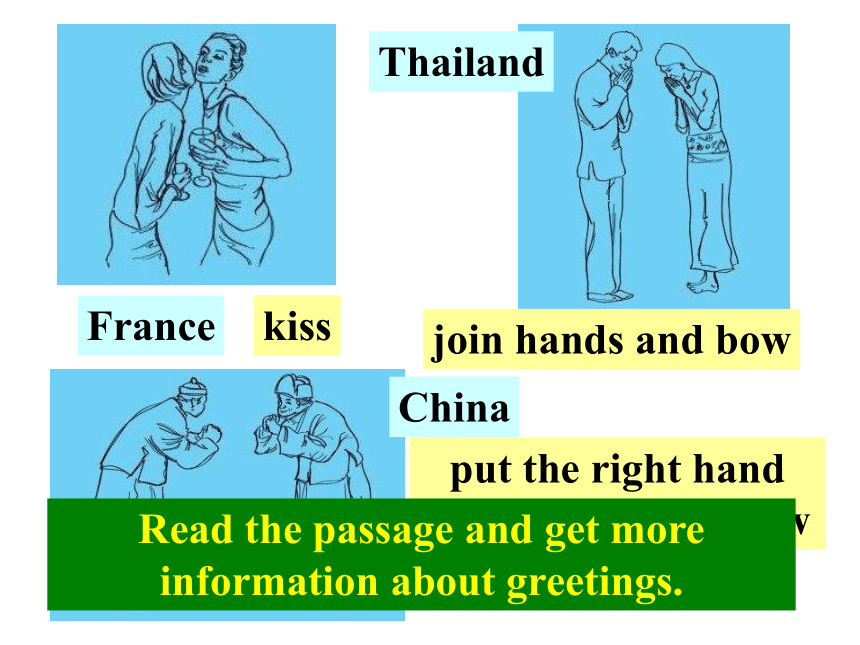


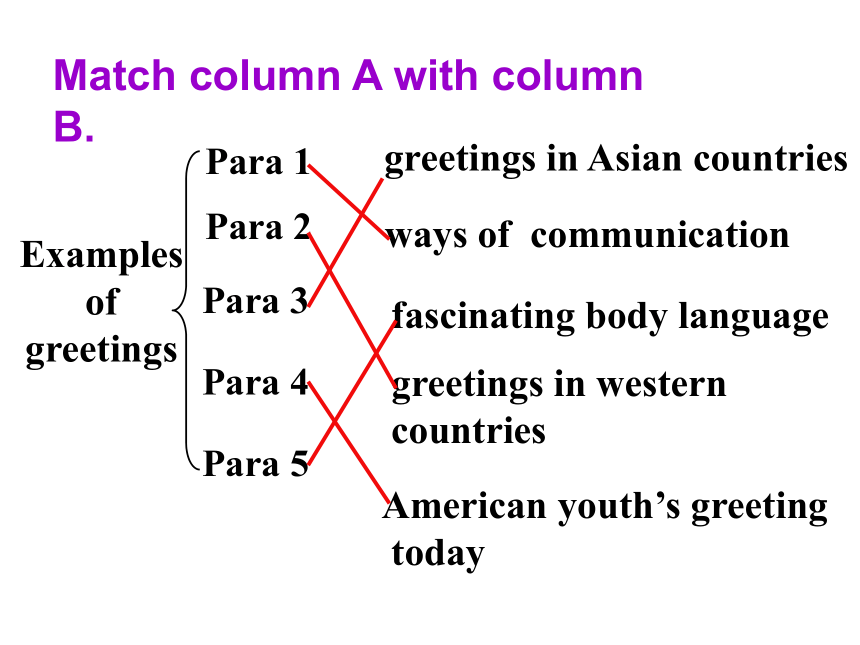
文档简介
课件37张PPT。Module 3
Body Language and Non-verbal Communication P2
Reading and Vocabulary Words and expressions Words and expressionsadj. 无意的;不知不觉的
v. 变化
on guard
adj. 正式的
adj. 攻击的;挑斗的;挑衅的
adv. 传统地
n. 武器
n. 姿势;姿态
adj. 恐吓的;具有威胁的 unconscious
vary
(保持)警惕
formal
aggressive
traditionally
weapon
gesture
threatening Words and expressions Words and expressions n. 协议;交易
达成协议;做成交易
v. 包括
adv. 轻微地;稍微
n. (常作复数)穆斯林
n. (穆斯林的)额手礼
n. 前额
n. 印度人
v. 鞠躬deal
make a deal
involve
slightly
Muslim
salaam
Forehead
Hindu
bow Words and expressions Words and expressions adj. 非正式的
n. 年轻人
举起
n. 手掌
v. 张开
v. 掌击
暴露(自己的情况)
能看透别人心思的人 informal
youth
hold up
palm
spread
slap
give away
mind reader on guard
make a deal
hold up
give away
mind reader达成协议;做成交易
暴露(自己的情况)
(自称或被认为) 能看透别人心思的人
举起
(保持)警惕MatchObjectives1. To get a general idea about greetings around the world
2. To summarize the main idea and retell the passage
3. To be able to talk about the different greetings around the world
4. To learn some key words and expressions in the passageWords:
vary formal aggressive involve bow spread communicate request
Expressions:
on guard make a deal
hold up give away
be busy with… be involved in…
read one’s mindFocus onHow to say in different countries?USAJapanhandshakebowFranceThailandChinakissjoin hands and bowput the right hand over the left and bowRead the passage and get more information about greetings. for
general ideasSkimminga. Saying It Without Words
b. When in Rome, Do as the Romans Do
c. Greetings Around the World
d. Read My MindRead the passage and choose the best title.Match column A with column B.Examples
of greetingsPara 1Para 2Para 3Para 4Para 5greetings in Asian countriesways of communicationfascinating body languagegreetings in western
countriesAmerican youth’s greeting
today for
specific informationScanning1. Not all body language is conscious.
2. Europeans shake hands with their
left hand.
3. In Asia, people touch strangers
when they meet.
4. In the US a “high five” is a way of
saying hello.
5. A “high five” is a formal gesture.
6. Body language is less communicative
than spoken or written language.P23 2right handdon’t
touch an informalmore1. Is unconscious body language a kind of “learned” body language?
A. No. B. Yes.
C. Maybe. D. Sure.
2. We use “learned” body language when we are _____.
A. introduced to strangers
B. greeting someone
C. carrying a weapon
D. busy with the talkingChoose the best answers. 3. Greetings in _____ countries do not
involve touching the other person.
A. African B. European
C. American D. Asian
4. What does the phrase “give away”
mean in the sentence “People give away
much more by their gestures than by
their words.”?
A. Express. B. Offer.
C. Send. D. Find.P23 3 aggressive deal gesture greet formal
informal position trust unconscious weapon1. Guns and knives are two different types of ________.
2. Someone who has a(n) _________ attitude may be violent.
3. You can ________ someone by saying “hello”.
4. Your ________ is the way you are sitting or standing.
5. If you are ___________ of something you do not know it is happening.weaponsaggressivegreetpositionunconsciousComplete the sentences with the words given.P23 3 aggressive deal gesture greet formal
informal position trust unconscious weapon6. A(n) ________ is a business agreement.
7. A(n) ________ is a movement of the body to communicate something.
8. If you ________ someone you believe them and rely on them.
9. “Give me five” is a(n) _________ greeting.
10. People are usually more ________ with people they don’t know.dealgesturetrustinformalformalComplete the table.Europeans, Americans ChinaMuslimsshake handsthe right handI trust you…put the right hand over the left and bow slightlythe handsshow respectsalaamheart, mouth, foreheadrespectJoin their hands and bow their headsthe hands,
headrespectthe handsay helloA “high five”HindusAmerican youths重难点句子分析Careful Reading1. When in Rome, Do as the Romans Do. 方式状语从句时间状语从句()在时间、条件、方式、让步等状语从句中,若从句和主句的主语一致或主句的主语是it,且从句谓语有动词 be时,可以省去从句的主语和be。入乡随俗。(you are)
>practice 1. 过马路时要小心。
Be careful when crossing the street.
2. 会议按计划在八点举行了。
The meeting took place at 8:00 as planned.2. We see examples of unconscious body language very often, yet there is also “learned” body language, which varies from culture to culture. yet连接并列句,表转折非限定性定语从句我们经常看到无意识的身势语,但也有“习得”的身势语。习得的身势语在不同的文化中各不相同。Salary?scales?vary?from?state?to state.
工资高低州与州不同。
The?samples?varied?in?quality?but were?generally?
acceptable.
这些样品质量有差异,但是大体上可以接受。practice 1. 这时钟是我祖父买的,现在走时还很准。
The clock, which is bought by my grandfather, is still in good order.
2. 汤姆从不和别人交流,这使他的父母非常担心。
Tom never communicates with others, which makes his parents worried. Post-readingactivities__________ and __________ shake hands. They do this with ____________ to show that they _____ you.EuropeansAmericansHow do people of different cultures greet each other?the right handtrust_______________ often greet each other with the expression, “____________!”One person ________ his hand, palm__________ and five fingers _______. The other person ______ his hand and _____the other’s open hand in a “__________”. American youthsGive me fiveholds upoutwardsspreadraisesslapshigh fiveA common greeting nowadaysGreetings in _______________do not involve ________ the other person, but they always involve _________ , which are busy with ____________ and cannot ______________.Asian countriesthe handstouchinghold a weaponthe greetingImitation show 模仿秀Let’s imitate (模仿) the greetings of different people, such as Europeans, Chinese, Muslims, Hindus, American youths.HindusMuslimsAmerican youthsChineseEuropeans
AmericansPlease remember: When in Rome, do as the Romans do. We communicate with spoken and written words and body positions. We find examples of unconscious body language and “learned” body language, which __________ culture ______ culture.
Every culture has developed a formal way to greet strangers. Traditionally, Europeans and Americans ___________. Greeting in Asian countries always ________ the hands. varies from to shake handsinvolveComplete the passage with proper words, which will help you retell the text.In these cultures, the hands ____________ the greeting and cannot hold a weapon. When people _______ each other today, they still use their hands as a gesture of trust. For example, the American youths often use the expression, “___________”. In reality, people __________ much more by their gestures than by their words. Look at your friends and family and see if you are a ___________! are busy with greetGive me five give away mind readerDo you agree with the following research result?Total communication 7% verbal feeling38% vocal feeling55% facial expressions100%We can speak in vocal organs, but we can use nonverbal gesture to communicate.
—— David AbercrombieNow 2 minutes to test our spelling.Spelling Bee English-Chinese
aggressive gesture threatening weapon traditionally informal
2. Chinese- English
鞠躬 暴露 达成协议 包括 (用语言、信号)传递信息,交流 张开 When finishing, exchange to see who does the best.Review课时重点回顾(保持)警惕
达成协议;做成交易
举起
暴露(自己的情况)
忙于……
被卷入;包含在
洞悉心思
握手
向……表示问候on guard
make a deal
hold up
give away
be busy with
be involved in
read one’s mind
shake hands
say hello to…Homework1. Read the passage again and review
the new words and expressions.
2. Read the articles in Learning
English. The more you read, the
faster and better you’ll understand.
When finishing reading, write a
summary in 100 words or so.
Body Language and Non-verbal Communication P2
Reading and Vocabulary Words and expressions Words and expressionsadj. 无意的;不知不觉的
v. 变化
on guard
adj. 正式的
adj. 攻击的;挑斗的;挑衅的
adv. 传统地
n. 武器
n. 姿势;姿态
adj. 恐吓的;具有威胁的 unconscious
vary
(保持)警惕
formal
aggressive
traditionally
weapon
gesture
threatening Words and expressions Words and expressions n. 协议;交易
达成协议;做成交易
v. 包括
adv. 轻微地;稍微
n. (常作复数)穆斯林
n. (穆斯林的)额手礼
n. 前额
n. 印度人
v. 鞠躬deal
make a deal
involve
slightly
Muslim
salaam
Forehead
Hindu
bow Words and expressions Words and expressions adj. 非正式的
n. 年轻人
举起
n. 手掌
v. 张开
v. 掌击
暴露(自己的情况)
能看透别人心思的人 informal
youth
hold up
palm
spread
slap
give away
mind reader on guard
make a deal
hold up
give away
mind reader达成协议;做成交易
暴露(自己的情况)
(自称或被认为) 能看透别人心思的人
举起
(保持)警惕MatchObjectives1. To get a general idea about greetings around the world
2. To summarize the main idea and retell the passage
3. To be able to talk about the different greetings around the world
4. To learn some key words and expressions in the passageWords:
vary formal aggressive involve bow spread communicate request
Expressions:
on guard make a deal
hold up give away
be busy with… be involved in…
read one’s mindFocus onHow to say in different countries?USAJapanhandshakebowFranceThailandChinakissjoin hands and bowput the right hand over the left and bowRead the passage and get more information about greetings. for
general ideasSkimminga. Saying It Without Words
b. When in Rome, Do as the Romans Do
c. Greetings Around the World
d. Read My MindRead the passage and choose the best title.Match column A with column B.Examples
of greetingsPara 1Para 2Para 3Para 4Para 5greetings in Asian countriesways of communicationfascinating body languagegreetings in western
countriesAmerican youth’s greeting
today for
specific informationScanning1. Not all body language is conscious.
2. Europeans shake hands with their
left hand.
3. In Asia, people touch strangers
when they meet.
4. In the US a “high five” is a way of
saying hello.
5. A “high five” is a formal gesture.
6. Body language is less communicative
than spoken or written language.P23 2right handdon’t
touch an informalmore1. Is unconscious body language a kind of “learned” body language?
A. No. B. Yes.
C. Maybe. D. Sure.
2. We use “learned” body language when we are _____.
A. introduced to strangers
B. greeting someone
C. carrying a weapon
D. busy with the talkingChoose the best answers. 3. Greetings in _____ countries do not
involve touching the other person.
A. African B. European
C. American D. Asian
4. What does the phrase “give away”
mean in the sentence “People give away
much more by their gestures than by
their words.”?
A. Express. B. Offer.
C. Send. D. Find.P23 3 aggressive deal gesture greet formal
informal position trust unconscious weapon1. Guns and knives are two different types of ________.
2. Someone who has a(n) _________ attitude may be violent.
3. You can ________ someone by saying “hello”.
4. Your ________ is the way you are sitting or standing.
5. If you are ___________ of something you do not know it is happening.weaponsaggressivegreetpositionunconsciousComplete the sentences with the words given.P23 3 aggressive deal gesture greet formal
informal position trust unconscious weapon6. A(n) ________ is a business agreement.
7. A(n) ________ is a movement of the body to communicate something.
8. If you ________ someone you believe them and rely on them.
9. “Give me five” is a(n) _________ greeting.
10. People are usually more ________ with people they don’t know.dealgesturetrustinformalformalComplete the table.Europeans, Americans ChinaMuslimsshake handsthe right handI trust you…put the right hand over the left and bow slightlythe handsshow respectsalaamheart, mouth, foreheadrespectJoin their hands and bow their headsthe hands,
headrespectthe handsay helloA “high five”HindusAmerican youths重难点句子分析Careful Reading1. When in Rome, Do as the Romans Do. 方式状语从句时间状语从句()在时间、条件、方式、让步等状语从句中,若从句和主句的主语一致或主句的主语是it,且从句谓语有动词 be时,可以省去从句的主语和be。入乡随俗。(you are)
>practice 1. 过马路时要小心。
Be careful when crossing the street.
2. 会议按计划在八点举行了。
The meeting took place at 8:00 as planned.2. We see examples of unconscious body language very often, yet there is also “learned” body language, which varies from culture to culture. yet连接并列句,表转折非限定性定语从句我们经常看到无意识的身势语,但也有“习得”的身势语。习得的身势语在不同的文化中各不相同。Salary?scales?vary?from?state?to state.
工资高低州与州不同。
The?samples?varied?in?quality?but were?generally?
acceptable.
这些样品质量有差异,但是大体上可以接受。practice 1. 这时钟是我祖父买的,现在走时还很准。
The clock, which is bought by my grandfather, is still in good order.
2. 汤姆从不和别人交流,这使他的父母非常担心。
Tom never communicates with others, which makes his parents worried. Post-readingactivities__________ and __________ shake hands. They do this with ____________ to show that they _____ you.EuropeansAmericansHow do people of different cultures greet each other?the right handtrust_______________ often greet each other with the expression, “____________!”One person ________ his hand, palm__________ and five fingers _______. The other person ______ his hand and _____the other’s open hand in a “__________”. American youthsGive me fiveholds upoutwardsspreadraisesslapshigh fiveA common greeting nowadaysGreetings in _______________do not involve ________ the other person, but they always involve _________ , which are busy with ____________ and cannot ______________.Asian countriesthe handstouchinghold a weaponthe greetingImitation show 模仿秀Let’s imitate (模仿) the greetings of different people, such as Europeans, Chinese, Muslims, Hindus, American youths.HindusMuslimsAmerican youthsChineseEuropeans
AmericansPlease remember: When in Rome, do as the Romans do. We communicate with spoken and written words and body positions. We find examples of unconscious body language and “learned” body language, which __________ culture ______ culture.
Every culture has developed a formal way to greet strangers. Traditionally, Europeans and Americans ___________. Greeting in Asian countries always ________ the hands. varies from to shake handsinvolveComplete the passage with proper words, which will help you retell the text.In these cultures, the hands ____________ the greeting and cannot hold a weapon. When people _______ each other today, they still use their hands as a gesture of trust. For example, the American youths often use the expression, “___________”. In reality, people __________ much more by their gestures than by their words. Look at your friends and family and see if you are a ___________! are busy with greetGive me five give away mind readerDo you agree with the following research result?Total communication 7% verbal feeling38% vocal feeling55% facial expressions100%We can speak in vocal organs, but we can use nonverbal gesture to communicate.
—— David AbercrombieNow 2 minutes to test our spelling.Spelling Bee English-Chinese
aggressive gesture threatening weapon traditionally informal
2. Chinese- English
鞠躬 暴露 达成协议 包括 (用语言、信号)传递信息,交流 张开 When finishing, exchange to see who does the best.Review课时重点回顾(保持)警惕
达成协议;做成交易
举起
暴露(自己的情况)
忙于……
被卷入;包含在
洞悉心思
握手
向……表示问候on guard
make a deal
hold up
give away
be busy with
be involved in
read one’s mind
shake hands
say hello to…Homework1. Read the passage again and review
the new words and expressions.
2. Read the articles in Learning
English. The more you read, the
faster and better you’ll understand.
When finishing reading, write a
summary in 100 words or so.
